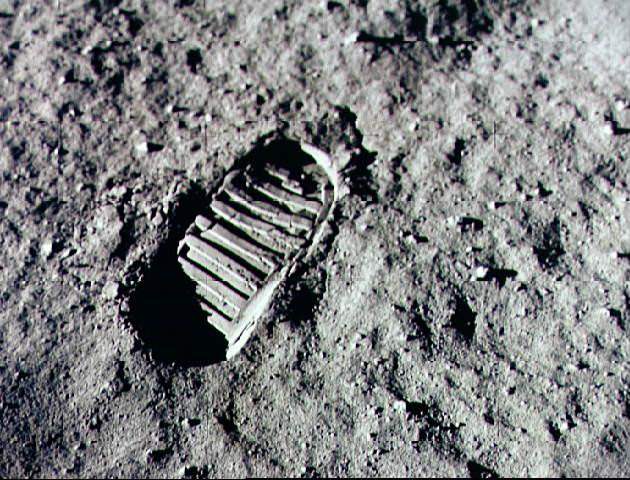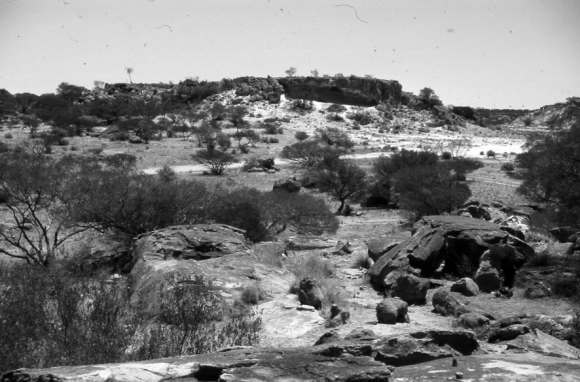Before NASA can mount its proposed “Journey to Mars“, which will see astronauts set foot on the Red Planet for the first time in history, a number of logistical and technical issues need to be addressed first. In addition to a launch vehicle (the Space Launch System), a crew capsule (the Orion Multi-Purpose Crew Vehicle), and a space station beyond the Moon (the Deep Space Gateway), the astronauts will also need a space habitat in orbit of Mars.
To build this habitat, NASA has reached out to its long-time contractor, Lockheed Martin. And on Saturday, September 28th, at the International Astronautical Congress (IAC) in Adelaide, Australia, the aerospace company revealed new details about its Mars Base Camp. When NASA’s proposed crewed mission to Mars takes place in the 2030s, this base will be the outpost from which crews will conduct research on the Martian surface.
The details revealed at the conference included how their proposed base camp aligns with other key components of NASA’s Mars mission, which Lockheed Martin is also working with NASA to develop. These include the Deep Space Gateway positioned in cislunar orbit, and a Mars surface lander – a reusable, single-stage craft capable of descending to the Martian surface from orbit.
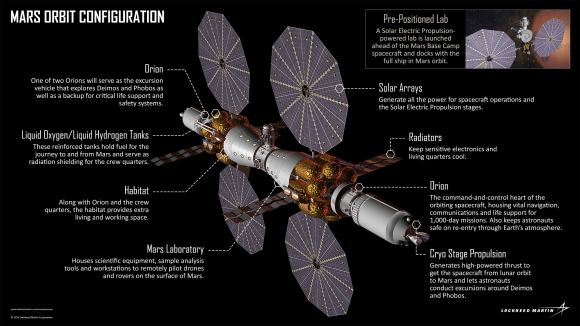
Along with NASA’s SLS and Orion spacecraft, these vital pieces of infrastructure will allow for not just one, but repeated crewed mission to Mars. As Lisa Callahan – the vice president and general manager of Commercial Civil Space at Lockheed Martin – said in the course of the company’s presentation at the IAC:
“Sending humans to Mars has always been a part of science fiction, but today we have the capability to make it a reality. Partnered with NASA, our vision leverages hardware currently in development and production. We’re proud to have Orion powered-on and completing testing in preparation for its Exploration Mission-1 flight and eventually its journey to Mars.”
Overall, the purpose of the Mars Base Camp is very simple. Basically, it consists of an orbital outpost where scientist-astronauts will be transported to after leaving Earth and flying from the Deep Space Gateway into orbit around Mars. From this base, crews will be able to conduct real-time scientific exploration of the Martian atmosphere, followed by missions to the surface.
As Lockheed Martin’s indicates on their website, the major components of their base camp will be launched separately. Some will be pre-positioned in orbit around Mars ahead of time while others will be assembled in cis-lunar space for the journey to Mars. In the end, six astronauts will launch on an Orion spacecraft – which serves as the heart of the Mars Base Camp interplanetary ship – and assemble all the component in orbit around Mars.
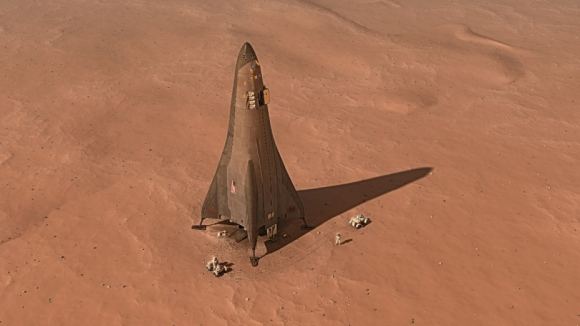
This is also consistent with Phase II and Phase III of NASA’s “Journey to Mars”, which are known as the “Proving Ground” and “Earth Independent” phases, respectively. Phase II calls for a series of missions to test the capabilities of the Space Launch System (SLS), Orion spacecraft, and deep space habitats, as well as multiple crewed missions and spacewalks in cislunar space.
Phase III will then consist of the refinement and testing of entry, descent, and landing techniques, as well as in-situ resource utilization. Once these are complete, Phase III will culminate with crewed missions to Martian orbit, followed by landed missions to the Martian surface. The first mission involving the Mars Base Camp are intended to be an extended stay in orbit around the Red Planet.
This will allow astronauts to gain vital experience with extended operations far from Earth and its protective magnetic field. This will be followed by the arrival of the surface lander, which would allow the astronauts to land and conduct missions on the surface. The lander would be mated to the base camp between missions and descend to the surface using supersonic retro-propulsion.
The lander also relies on Orion avionics and systems as its command deck, and is powered by engines that use a liquid-hydrogen/liquid-oxygen propellant. Each mission to the surface would likely last two weeks at a time and consist of four astronauts conducting research and collecting samples for return to the base camp. The crews would then take off in the Lander and return it the station, where it would refuel and restock for future missions.
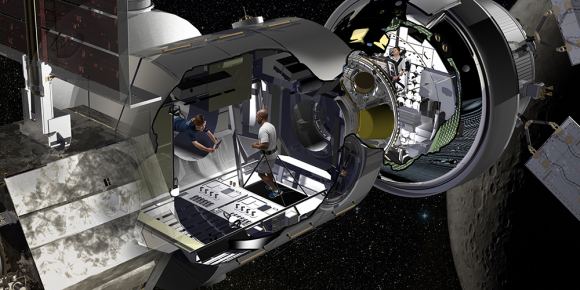
Since the lander’s fuel can be manufactured from water, it is likely that a source of subsurface water ice will also come into play during these surface missions. If the necessary infrastructure is brought to the surface, it could even be used for the in-situ manufacture of rocket fuel. As such, it is understandable by locating a source of subsurface water ice is a major focal point of future NASA and SpaceX missions.
As noted, the Mars Base Camp is aligned with other mission components, which include the Deep Space Gateway. Here too, NASA has contracted Lockheed Martin to develop the concept’s architecture. This past summer, the company was awarded a Phase II contract by NASA to create designs for this space habitat, which is intended to build on the lessons learned from the International Space Station (ISS).
The contract was awarded as part of the Next Space Technologies for Exploration Partnership (NextSTEP) program, which NASA launched in 2014. In April of 2016, during the second NextSTEP Broad Agency Announcement (NextSTEP-2), NASA selected six U.S. companies to begin building full-sized ground prototypes and concepts for this deep space habitat.
In the end, the Deep Space Gateway and the Mars Base Camp will allow for the development and testing of other space systems in cis-lunar space before sending them on to Mars. The Gateway will also allow astronauts to conduct lunar research and live and work in orbit around the Moon for months at a time. This will come in handy once they begin making transits to and from Mars.
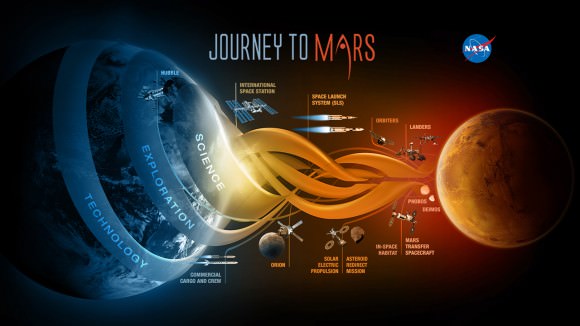
Ever since NASA first announced its proposal for a “Journey to Mars” in 2010, scientists, space enthusiasts and the general public ave eagerly awaited the release of key details. Given that such a mission comes with major technical and logistical challenges, how they intend to address them has been a major point of interest. Other points of interest have included timelines as well as the vehicles, systems and technologies that would be involved.
This latest announcement is just one of many to be made by NASA and its partners in recent months. As the “Journey to Mars” slowly approaches, more and more details have become available, and what this mission will look like has slowly taken form. As Lockheed Martin states on their website:
“Since the first Viking lander touched down on Mars 40 years ago, humanity has been fascinated with the Red Planet. Lockheed Martin built NASA’s first Mars lander and has been a part of every NASA Mars mission since. We’re ready to deliver the future, faster. Mars is closer than you think. We’re ready to accelerate the journey.”
And be sure to check out this promotional video about the Mars Base Camp, courtesy of Lockheed Martin:
Further Reading: Lockheed Martin, LM – Mars Base Camp


